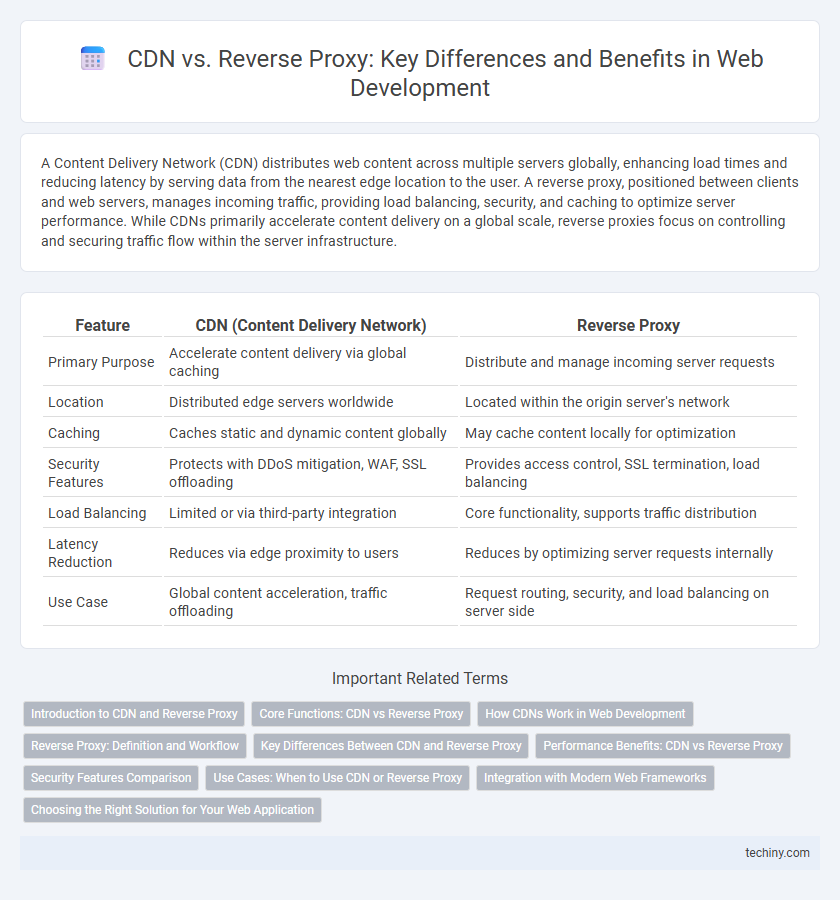A Content Delivery Network (CDN) distributes web content across multiple servers globally, enhancing load times and reducing latency by serving data from the nearest edge location to the user. A reverse proxy, positioned between clients and web servers, manages incoming traffic, providing load balancing, security, and caching to optimize server performance. While CDNs primarily accelerate content delivery on a global scale, reverse proxies focus on controlling and securing traffic flow within the server infrastructure.
Table of Comparison
| Feature | CDN (Content Delivery Network) | Reverse Proxy |
|---|---|---|
| Primary Purpose | Accelerate content delivery via global caching | Distribute and manage incoming server requests |
| Location | Distributed edge servers worldwide | Located within the origin server's network |
| Caching | Caches static and dynamic content globally | May cache content locally for optimization |
| Security Features | Protects with DDoS mitigation, WAF, SSL offloading | Provides access control, SSL termination, load balancing |
| Load Balancing | Limited or via third-party integration | Core functionality, supports traffic distribution |
| Latency Reduction | Reduces via edge proximity to users | Reduces by optimizing server requests internally |
| Use Case | Global content acceleration, traffic offloading | Request routing, security, and load balancing on server side |
Introduction to CDN and Reverse Proxy
A Content Delivery Network (CDN) is a distributed server network designed to deliver web content quickly by caching static assets closer to users, reducing latency and improving load times. A Reverse Proxy sits between client devices and web servers, managing and forwarding client requests to optimize security, load balancing, and performance. Both technologies enhance web delivery but serve distinct roles: CDNs focus on content distribution globally, while reverse proxies handle request management and security at the server level.
Core Functions: CDN vs Reverse Proxy
Content Delivery Networks (CDNs) primarily focus on distributing web content across geographically dispersed servers to reduce latency and improve load times for end users. Reverse proxies serve as intermediaries between clients and servers, managing request routing, load balancing, and enhancing security by filtering traffic. While CDNs optimize content delivery and caching, reverse proxies provide centralized control over incoming requests and backend server protection.
How CDNs Work in Web Development
CDNs (Content Delivery Networks) improve web development by caching static content across distributed edge servers, reducing latency and bandwidth usage. They deliver resources like images, scripts, and stylesheets from servers geographically closer to users, enhancing load times and overall performance. CDNs also provide security features such as DDoS protection and SSL offloading, optimizing both speed and safety for websites.
Reverse Proxy: Definition and Workflow
A reverse proxy acts as an intermediary server that forwards client requests to backend servers, enhancing security, load balancing, and caching. It processes incoming traffic by intercepting requests, applying security policies or optimizations, and then routing them efficiently to the appropriate origin server. This workflow ensures improved performance, reduced server load, and protection against attacks within web development infrastructures.
Key Differences Between CDN and Reverse Proxy
Content Delivery Networks (CDNs) enhance website performance by distributing cached content across multiple global servers, reducing latency and improving load times for end users. Reverse proxies act as intermediaries between client requests and backend servers, providing security functions like request filtering, SSL termination, and load balancing. While CDNs primarily focus on content distribution and acceleration, reverse proxies emphasize traffic management and protecting origin servers from direct exposure.
Performance Benefits: CDN vs Reverse Proxy
Content Delivery Networks (CDNs) significantly enhance web performance by distributing content across global edge servers, reducing latency and improving load times for users worldwide. Reverse proxies optimize server load by caching content and managing incoming requests, which lowers backend server strain and accelerates response time within local or regional scopes. While CDNs excel in delivering static assets efficiently at a global scale, reverse proxies provide dynamic request handling and security benefits closer to the origin server, collectively improving website speed and reliability.
Security Features Comparison
Content Delivery Networks (CDNs) enhance security by mitigating DDoS attacks, providing Web Application Firewalls (WAF), and ensuring SSL/TLS encryption at the edge, reducing direct server exposure. Reverse proxies offer security benefits through request filtering, IP masking, and load balancing, acting as an intermediary to prevent direct access to backend servers and enabling granular access control. While CDNs focus on global content delivery security, reverse proxies emphasize internal network protection and traffic management within a controlled infrastructure.
Use Cases: When to Use CDN or Reverse Proxy
CDNs are ideal for delivering static content like images, videos, and scripts quickly to global users by caching content at edge servers, improving load times and reducing latency. Reverse proxies excel in managing web traffic, enhancing security through request filtering, load balancing, and SSL termination, making them suitable for handling dynamic content and backend server management. Use a CDN to optimize content delivery for widespread audiences and a reverse proxy to secure and distribute traffic across multiple backend servers.
Integration with Modern Web Frameworks
CDNs seamlessly integrate with modern web frameworks by caching static assets and delivering content through edge servers, reducing latency and improving load times across distributed networks. Reverse proxies enhance web framework performance by managing server requests, enabling load balancing, SSL termination, and security enforcement without modifying the application layer. Both technologies complement frameworks like React, Angular, and Vue.js by optimizing content delivery and request handling to ensure scalable, high-performance web applications.
Choosing the Right Solution for Your Web Application
Selecting between a Content Delivery Network (CDN) and a reverse proxy depends on your web application's goals such as performance optimization, security, and scalability. CDNs enhance global content delivery by caching static assets closer to users, reducing latency and server load. Reverse proxies improve backend server management by handling request routing, load balancing, and providing additional security layers, making them ideal for dynamic content and application-level control.
CDN vs Reverse Proxy Infographic

 techiny.com
techiny.com